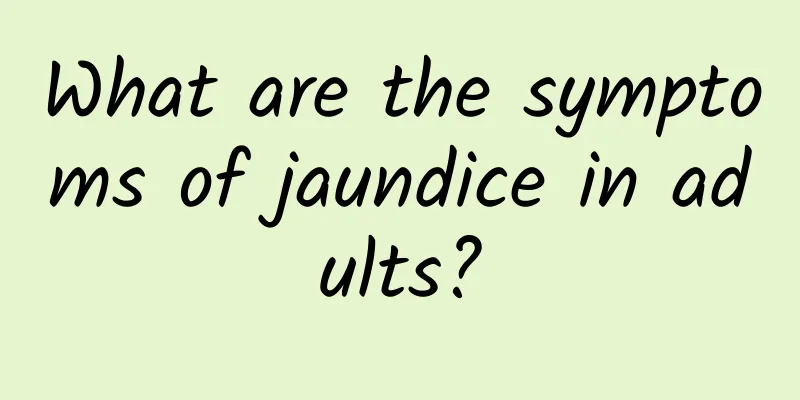What are the symptoms of jaundice in adults?

|
Jaundice is a relatively common symptom that often occurs in newborns. Adults who develop jaundice must also be vigilant, as it is often caused by some liver and gallbladder diseases. It not only causes jaundice, but may also cause fever, gastrointestinal symptoms, nausea, vomiting, abdominal distension and other symptoms. Let’s take a look at the symptoms of jaundice in adults. What are the symptoms of jaundice in adults? 1. Basic symptoms (1) The skin, sclera and other tissues become yellow and itchy. When jaundice deepens, urine, sputum, tears and sweat also turn yellow, but saliva generally does not change color. (2) Urine tastes like strong tea and stool tastes like clay. (3) Gastrointestinal symptoms, often including abdominal distension, abdominal pain, loss of appetite, nausea, vomiting, diarrhea or constipation. (4) Manifestations of hypercholesterolemia: the main symptoms include: skin itching, bradycardia, abdominal distension, steatorrhea, night blindness, fatigue, mental depression and headache, etc. 2. Associated symptoms (1) Jaundice with fever is seen in acute cholangitis, liver abscess, leptospirosis, sepsis, and lobar pneumonia. Viral hepatitis or acute hemolysis may first cause fever and then jaundice. (2) Jaundice accompanied by severe upper abdominal pain may be seen in biliary stones, liver abscess or biliary ascariasis. Severe pain in the right upper abdomen, chills, high fever and jaundice are Charcot triad, indicating acute suppurative cholangitis. Persistent dull pain or bloating in the right upper abdomen may be seen in viral hepatitis, liver abscess, or primary liver cancer. (3) Jaundice with hepatomegaly. If the enlargement is mild to moderate, the texture is soft or of medium hardness and the surface is smooth, it is seen in acute biliary infection or biliary obstruction caused by viral hepatitis. Obvious swelling, hard texture, uneven surface and nodules are seen in primary or secondary liver cancer. Liver enlargement is not obvious, but the texture is hard, the edges are irregular, and there are small nodules on the surface, which is seen in cirrhosis. 3. Abdominal signs (1) Abdominal appearance: Liver space-occupying lesions, splenomegaly, retroperitoneal tumors, and pelvic tumors all have local bulging in the corresponding parts. When there is a large amount of ascites, the abdomen will appear frog-shaped, with a protruding umbilicus. Abdominal wall hernia and umbilical hernia may also occur. Varicose veins of the abdominal wall are seen in portal hypertension, portal vein or inferior vena cava obstruction. (2) Liver condition: In acute viral hepatitis or toxic hepatitis, jaundice and hepatomegaly coexist. The liver is soft, and tenderness and percussion pain are more obvious. In acute and subacute liver necrosis, jaundice rapidly deepens, but the liver does not enlarge or may even shrink. In chronic hepatitis and cirrhosis, the liver enlargement is not as obvious as in acute hepatitis, and the texture increases and there may be no tenderness. In cirrhosis, uneven edges and large and small nodules may also be felt. In liver cancer, the liver may be enlarged and lose its normal shape, become hard in texture, and may have large masses or smaller nodules palpable. Tenderness may not be significant, but a smooth liver surface cannot rule out deep cancer or subclinical "small liver cancer." When the liver abscess is close to the surface of the liver, the local skin may have signs of inflammation such as redness, swelling, and tenderness. In cases of giant liver abscess, echinococcosis, polycystic liver, and hepatic cavernous hemangioma, the liver area may have a cystic or fluctuating feeling. (3) Splenomegaly and jaundice accompanied by splenomegaly are more common in the decompensated stage of various types of liver cirrhosis, chronic active hepatitis, acute hepatitis, hemolytic jaundice, systemic infectious diseases and infiltrative diseases. When cancer invades the portal vein and splenic vein, it can cause splenomegaly. Rare splenic infarction and splenic abscess can also cause similar splenomegaly and tenderness. |
<<: What are the symptoms of blood deficiency causing wind?
>>: What are the symptoms of getting angry after eating donkey-hide gelatin?
Recommend
What to do if left eyelid spasms
Eyelid spasms are quite common in daily life, tha...
What are the symptoms of favism hemolysis
The early symptoms of favism hemolysis include di...
How many days does it take to be hospitalized for arrhythmia?
We all know that heart attacks are particularly d...
What does Chinese patent medicine mean?
Medicines are very common, especially those for t...
Itchy red palms with red spots under the skin
Itching and the appearance of red spots on the pa...
Is back pain caused by kidney deficiency? Do you understand now?
Nowadays, kidney deficiency is no longer a diseas...
Is eating maca regularly harmful to the body?
If you take maca frequently, it will definitely b...
Can conjunctival edema be cured?
Conjunctival edema is a manifestation of conjunct...
Do you know the common human herpes viruses?
In clinical practice at STD hospitals, herpes vir...
What causes itchy nails?
Onychomycosis is an unforgettable nightmare for ma...
Will laser freckle removal cause recurrence?
With our constant pursuit of beauty and the conti...
What to do if you have habitual dislocation
Dislocation is mainly caused by shoulder joint, a...
What does HBcAb positive mean?
HBcAb is the abbreviation of an English name. Its...
Buttock bone pain
Although there is a lot of fat on the buttocks an...
Why do babies lean back when they cry?
When babies cry, they always like to struggle and...









